In October, we packed the car and headed out on a driving tour across Southern France to Barcelona. Our first stop was Geneva, where we stayed with our friends Carol and Nathaniel. They, and their kids Oscar and Pascale, treated us to lovely food and wine, much of it from just across the border in France. They also took us to a wonderful restaurant in France, halfway up a mountain pass, called Le Refuge de Florimont, which had views over Lake Geneva to Mont Blanc (alas, the clouds prevented us from seeing the famous peak).
We also dropped in on Patrick and Lisa, in the nearby French village of Thoiry.  Along with their kids, we saw the local festival of St Maurice, which included a fascinating parade (one group comprised six locals plodding along together on a single pair of giant skis). Children were given helium balloons to release with their names and addresses attached, and Wiki’s managed to reach a friendly grandmother in Bordeaux some 500km away on the opposite side of France.
Along with their kids, we saw the local festival of St Maurice, which included a fascinating parade (one group comprised six locals plodding along together on a single pair of giant skis). Children were given helium balloons to release with their names and addresses attached, and Wiki’s managed to reach a friendly grandmother in Bordeaux some 500km away on the opposite side of France.
We then drove across the south-east corner of France to the fishing village of Meze, situated beside a large lagoon on the mediterranean coast — it’s near Montpelier. The weather was still warm enough to spend time on the beach, and the boys collected shells, splashed about in the shallows and just lounged around (as seen at right) much like their parents.
After a couple of days of sunshine, we followed the coast around to Barcelona, taking a short side-trip to see the enormous castle at Carcasonne, a world heritage site. The walls of the medieval fort surround an entire small town, which, although inhabited by a warren of tourist shops, is well restored and stunning in scale.
In Barcelona, we stayed with David and Laura, whose three children bracket ours in age.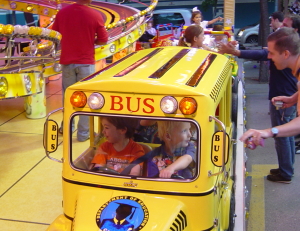 The five kids had great fun together, especially attending the Festa Major de Sarrià (an annual parade held by the local village). Four metre tall figures danced, along with dragons who breathed real fire via natural gas nozzles. There were also fun rides, as shown at left.
The five kids had great fun together, especially attending the Festa Major de Sarrià (an annual parade held by the local village). Four metre tall figures danced, along with dragons who breathed real fire via natural gas nozzles. There were also fun rides, as shown at left.
While in Barcelona, we also caught up with Carina, one of our German helpers from Sydney — she’s living there now — and we had a wonderful lunch with Ana (we last visited her nine years ago on our way through Braga, Portugal). Alas, on a trip to see the Sagrada Familia, Mark’s wallet was pick-pocketed on the metro, leading to several hours spent at police stations and calling credit card issuers.
We then headed back, via Meze once more, to Avignon, where we stayed in a 16th century hunting lodge that’s been converted into a luxurious bed and breakfast, Domaine de Rhodes. The owners, Françoise & Paco, have done a fantastic job of renovating the place, and share formal breakfast with their guests in the ornate dining room. They even lent us their bicycles so that we could ride around the Île de la Barthelasse on which the lodge stands in the Rhone river. 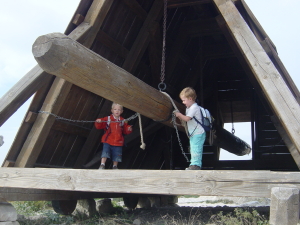 We twice had dinner outdoors at a restaurant on the banks of the river, with views to the papal palace and the remaining arches of the Saint Bénézet bridge (made famous in the French children’s song Sur le pont d’Avignon).
We twice had dinner outdoors at a restaurant on the banks of the river, with views to the papal palace and the remaining arches of the Saint Bénézet bridge (made famous in the French children’s song Sur le pont d’Avignon).
From there we headed south to the fortified village of Les Baux de Provence, which makes good use of the jagged terrain to create an impregnable defensive position. It has an impressive collection of medieval siege engines, including the largest trebuchet in Europe (which can throw a 100kg stone more than 180 metres) and the battering ram shown here. We couldn’t stay long though — giving Wiki and Loxon enough time to figure out that these machines actually worked could have led to destruction beyond even their normally wanton standards.
Our next stop was Vence, a town in the hills above Nice, where we stayed with Karina and Slah, and their son Eskander (pictured below with Wiki). As usual, Slah prepared delectable food for us all, and showed us around the charming old part of the town. Reminiscent of our visit to nearby St-Paul-de-Vence some ten years earlier,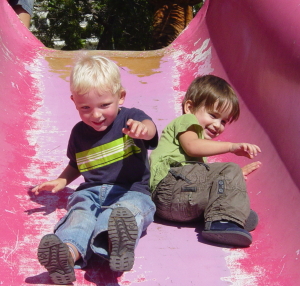 it was filled with narrow stone alleys and beautiful art galleries, but is far less touristed.
it was filled with narrow stone alleys and beautiful art galleries, but is far less touristed.
On our second afternoon in Vence we had the only substantial rain of the holiday, and decided to take the boys out in their gumboots to a local park. Loxon climbed into the fork of a small olive tree, then slipped in his boots and fell less than a metre onto asphalt. Unfortunately, this was enough to fracture his elbow — a hairline crack through the growth plate of his ulna.
At the hospital in Cagnes-sur-Mer that evening, the x-rays didn’t show the fracture, but the doctor on duty decided to put on a cast anyway, and told us to visit a paediatric hospital in Nice the next day. That turned out to be the Hôpital Lenval, where Angelina Jolie had her twins delivered in 2008. Here new x-rays were taken in which the surgeon found the break, and a new cast was put on. Loxon tolerated the waiting and a great deal of pain well, while we felt guilty about having let him climb in gumboots. On the other hand it is astonishing, given Loxon’s cavalier approach to physical risk and pain, that he reached the age of four before he broke his first bone.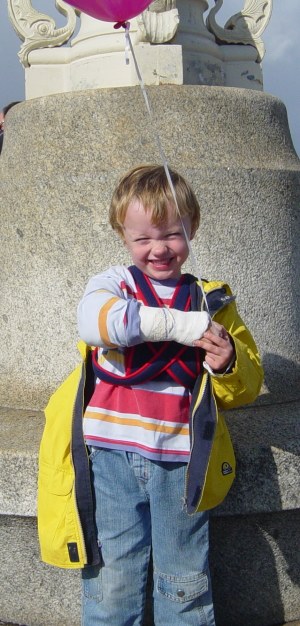 Time will tell whether this will slow him down, or simply be the first of a long sequence.
Time will tell whether this will slow him down, or simply be the first of a long sequence.
It was then time to head home via Italy, braving the narrow, winding highway along the Mediterranean coast, with mad Italian drivers who seemed to have a different interpretation of lane markings from that found in other countries. What with getting stuck in peak hour traffic while skirting Milan, it took five hours driving to reach Lake Como. We had booked a room with views over the lake in Torno, and thought we knew how to get there based on Google Maps. On our arrival after dark, we discovered that it was impossible to reach the hotel by car — but not before we had attempted to drive down a barely car-width laneway which ended at the top of a flight of stairs. Thankfully a local helped us turn around by opening their gate.
The following morning dawned in beautiful sunshine, and we packed the car for the final three hours drive home. We drove up into Switzerland with views across sunny Lakes Como, Lugano and Maggiore, to reach the entrance to the St Gotthard tunnel. At 16.4km long, it is the world’s third longest road tunnel (for twenty years it was the longest). It takes more then twelve minutes to drive through it, which is an eternity when you are staring at identical round tunnel walls. When we entered the tunnel at the south end, the sky was clear and it was reasonably warm. When we exited on the north side, a fog had closed in and it was near freezing. We didn’t see the sun again on the rest of the way home. It was like leaving summer behind on the other side of the mountains and entering winter. But then the alps are the largest mountain range in Europe — it’s not surprising the weather can differ so dramatically on either side.
 Thursday, August 13, 2009 at 12:21PM
Thursday, August 13, 2009 at 12:21PM 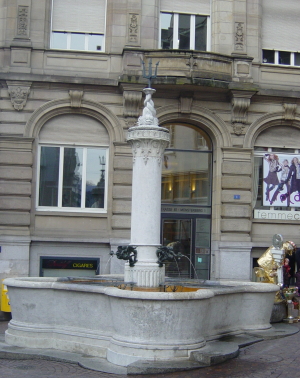 It sports four basilisks, each spouting its own stream of water, a column incorporating a Doric lower part and a Corinthian style capital, three dolphins and a trident, hardly a cohesive combination. But perhaps that suits the jumble of branded merchants that crowd Basel’s most fashionable retail street.
It sports four basilisks, each spouting its own stream of water, a column incorporating a Doric lower part and a Corinthian style capital, three dolphins and a trident, hardly a cohesive combination. But perhaps that suits the jumble of branded merchants that crowd Basel’s most fashionable retail street. 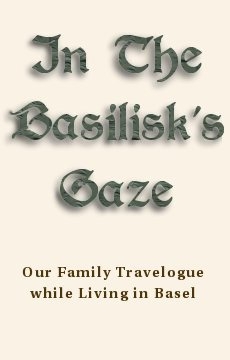
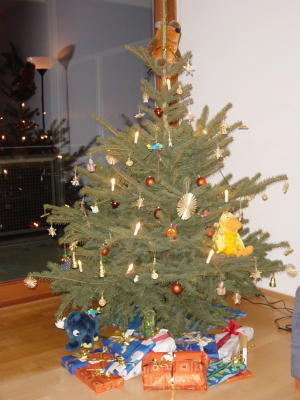 The man on
The man on 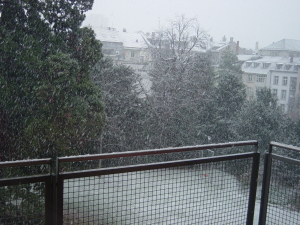 With two small kids, this is somewhat involved: the car must be collected from its parking spot and brought home to have car seats installed, and the same procedure needs to be reversed afterwards. Everything went smoothly, with the boys going to sleep in the guest room part-way through the party, and dozing off in the car on the way home. But in the rush to get them into their beds without too much rousing, we forgot to take out the car seats. It wasn’t until shortly before midnight, as Mark locked the car at the parking spot and was about to mount his bike for the ride home, that he noticed the two car seats still in the car. Since the seats are too heavy to carry together, he had to call Mobility and rebook the car for an additional half-hour.
With two small kids, this is somewhat involved: the car must be collected from its parking spot and brought home to have car seats installed, and the same procedure needs to be reversed afterwards. Everything went smoothly, with the boys going to sleep in the guest room part-way through the party, and dozing off in the car on the way home. But in the rush to get them into their beds without too much rousing, we forgot to take out the car seats. It wasn’t until shortly before midnight, as Mark locked the car at the parking spot and was about to mount his bike for the ride home, that he noticed the two car seats still in the car. Since the seats are too heavy to carry together, he had to call Mobility and rebook the car for an additional half-hour.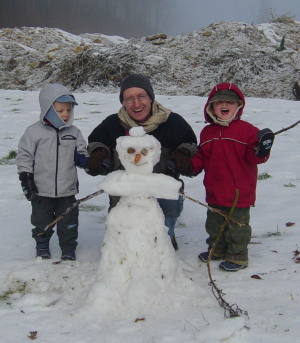 Although some heavy snowfalls had passed through Basel, our proximity to the warming influence of the river meant that there was never enough to build anything approaching a snowman. Having promised the boys there would be one, we drove out of Basel on New Year’s Day and up into the hills. The small town of
Although some heavy snowfalls had passed through Basel, our proximity to the warming influence of the river meant that there was never enough to build anything approaching a snowman. Having promised the boys there would be one, we drove out of Basel on New Year’s Day and up into the hills. The small town of 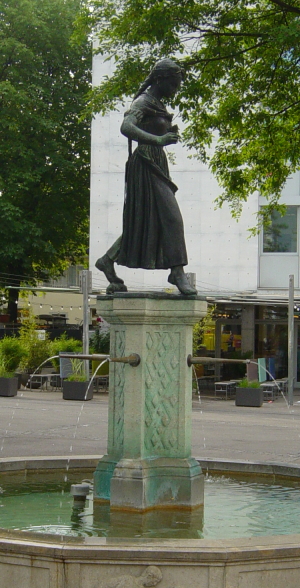 It was built in 1954 by the German sculptor
It was built in 1954 by the German sculptor 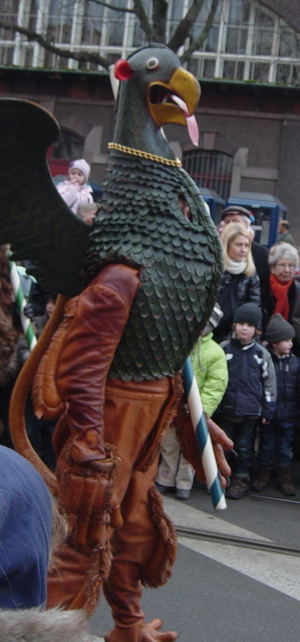 Given Marina’s penchant for the ancient world, it was necessary to visit Basel’s
Given Marina’s penchant for the ancient world, it was necessary to visit Basel’s  They even do a dance on the Mittlere Brücke (middle bridge), but they are careful never to face the Grossbasel side of the river — a consequence of the rivalry between the two half cities. The whole process is naturally electrifying for small children, who run after the procession with wild eyes. Loxon and Wiki were especially intrigued when the Vogel Gryff “took his head off” and stepped into a local restaurant for some well-earned sustenance. But the event was a mere hint of what was to come in Fasnacht itself.
They even do a dance on the Mittlere Brücke (middle bridge), but they are careful never to face the Grossbasel side of the river — a consequence of the rivalry between the two half cities. The whole process is naturally electrifying for small children, who run after the procession with wild eyes. Loxon and Wiki were especially intrigued when the Vogel Gryff “took his head off” and stepped into a local restaurant for some well-earned sustenance. But the event was a mere hint of what was to come in Fasnacht itself.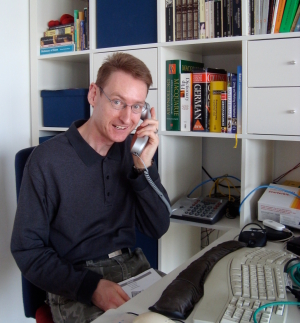
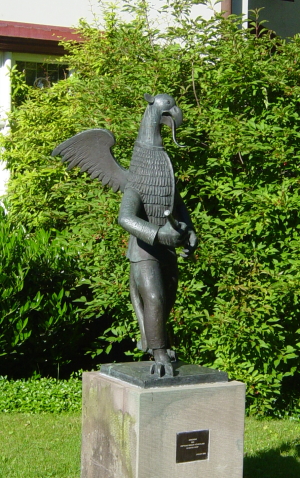 The sanatorium was the first hospital for those tuberculosis sufferers unable to pay for their own treatment, which subsequently became a model for such public sanatoria all over Europe. Every
The sanatorium was the first hospital for those tuberculosis sufferers unable to pay for their own treatment, which subsequently became a model for such public sanatoria all over Europe. Every 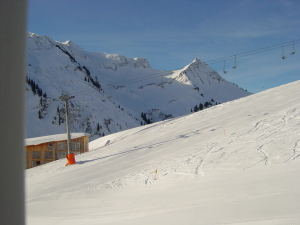 But in the interests of catching up, we’ll postpone our description of it until next year when it will happen again in all its madness.
But in the interests of catching up, we’ll postpone our description of it until next year when it will happen again in all its madness.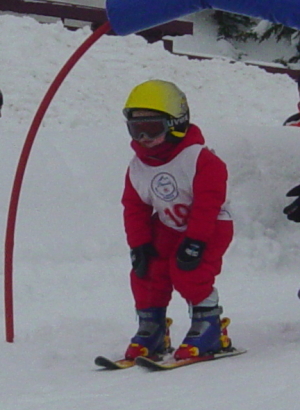 In theory, parents could drop off their kids and head out to ski themselves, an idea that had both Marion and Mark dreaming of gliding away over smooth snow in an ecstacy of freedom. In practice, things were rather different. Although Wiki and Loxon were keen on the idea of skiing, it turned out to involve much more effort than they had expected, and they were soon tired and emotional little skiers. This meant that Mark and Marion were required to remain with the class for support. If that sounds like your idea of fun, try crawling around on your hands and knees in the snow, lifting up 15 kilo kids every 30 seconds and having helmeted heads smash alternately into your stomach and then your groin at high speed for, oh say, an hour. After a few days of this we were ready to go home for a holiday. But at least the snow was powdery and beautiful, and we did get to do some skiing too.
In theory, parents could drop off their kids and head out to ski themselves, an idea that had both Marion and Mark dreaming of gliding away over smooth snow in an ecstacy of freedom. In practice, things were rather different. Although Wiki and Loxon were keen on the idea of skiing, it turned out to involve much more effort than they had expected, and they were soon tired and emotional little skiers. This meant that Mark and Marion were required to remain with the class for support. If that sounds like your idea of fun, try crawling around on your hands and knees in the snow, lifting up 15 kilo kids every 30 seconds and having helmeted heads smash alternately into your stomach and then your groin at high speed for, oh say, an hour. After a few days of this we were ready to go home for a holiday. But at least the snow was powdery and beautiful, and we did get to do some skiing too.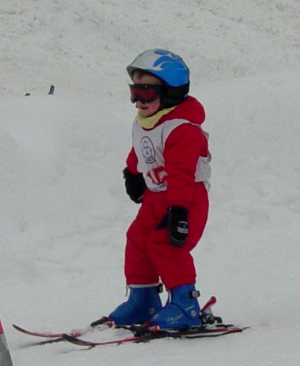 They were proud to participate in the class race at the end of the week, for which they were announced as the Australian contingent. And neither of them laughed even once as giant blue bunny rabbits handed them their medals.
They were proud to participate in the class race at the end of the week, for which they were announced as the Australian contingent. And neither of them laughed even once as giant blue bunny rabbits handed them their medals.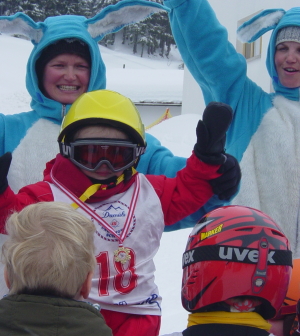 Thus distracted, he regained full conciousness without distress and was able to go home for the night. It took another six weeks of doctor visits and disinfectant baths before his hand was back to normal. The only sign left of the injury now is a small scar across the pad of his finger.
Thus distracted, he regained full conciousness without distress and was able to go home for the night. It took another six weeks of doctor visits and disinfectant baths before his hand was back to normal. The only sign left of the injury now is a small scar across the pad of his finger.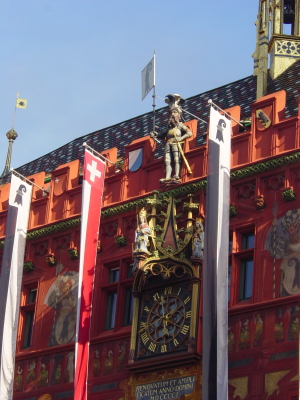 The clock and the golden turret just visible in the upper right, were also part of the original building.
The clock and the golden turret just visible in the upper right, were also part of the original building.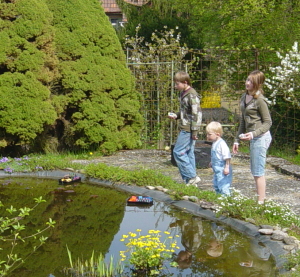 Buyers then browse row upon row of bikes and get the opportunity to test-ride them on a large circuit before choosing. Although we weren’t the earliest arrivals, Marion did find an excellent Swiss bicycle in bright red, complete with hub dynamo lights and integrated wheel-lock.
Buyers then browse row upon row of bikes and get the opportunity to test-ride them on a large circuit before choosing. Although we weren’t the earliest arrivals, Marion did find an excellent Swiss bicycle in bright red, complete with hub dynamo lights and integrated wheel-lock.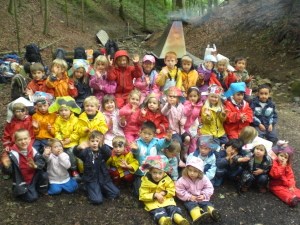 And, as luck would have it, the pirates discovered treasure in the forest. Wiki is in yellow, third from left in the second row; and Loxon is in dark and light blue, fourth from right in the first row. They do all look rather menacing. On coming home the boys reported, in tones of fascination, that even pirates have to brush their teeth. Who would have thought it?
And, as luck would have it, the pirates discovered treasure in the forest. Wiki is in yellow, third from left in the second row; and Loxon is in dark and light blue, fourth from right in the first row. They do all look rather menacing. On coming home the boys reported, in tones of fascination, that even pirates have to brush their teeth. Who would have thought it?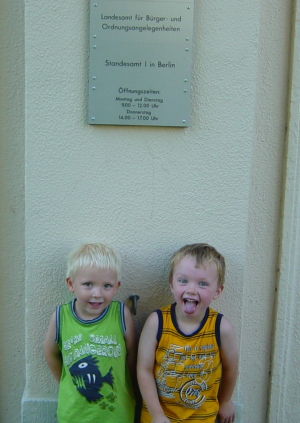 Only another two hours later we were swimming in Potsdams’ sun-laden
Only another two hours later we were swimming in Potsdams’ sun-laden 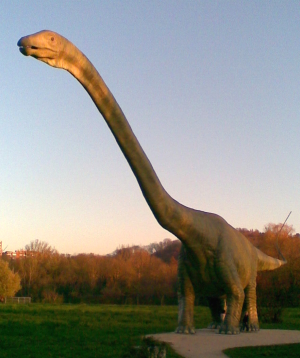 It adjoins the
It adjoins the 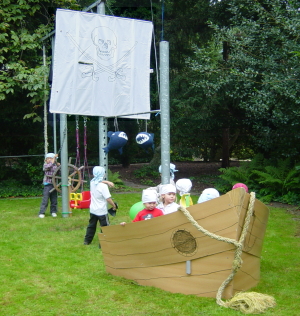 After the excitement of the pirate summer camp, it was obvious what theme their birthday party would have, and invitations were sent out to all of Wiki and Loxon’s favourite pirate friends. Three weeks before the appointed date there was a council collection, so Mark went out to see what materials could be scavenged. He was surprised by what he found. There was a storage unit, whose ribbed canvas walls were perfect for a sail; the backing panels of an Ikea wardrobe, which flexed easily to form the hull of a ship; and even a costume hand-hook. With the aid of some sawing, a few screws and a marker pen, the ship shown at right was quickly assembled. Uncle Jürgen lent us a fantastic ship’s wheel and rope, while Aunt Sabine furnished the pirate flag. Given the zero budget, we were delighted with the result.
After the excitement of the pirate summer camp, it was obvious what theme their birthday party would have, and invitations were sent out to all of Wiki and Loxon’s favourite pirate friends. Three weeks before the appointed date there was a council collection, so Mark went out to see what materials could be scavenged. He was surprised by what he found. There was a storage unit, whose ribbed canvas walls were perfect for a sail; the backing panels of an Ikea wardrobe, which flexed easily to form the hull of a ship; and even a costume hand-hook. With the aid of some sawing, a few screws and a marker pen, the ship shown at right was quickly assembled. Uncle Jürgen lent us a fantastic ship’s wheel and rope, while Aunt Sabine furnished the pirate flag. Given the zero budget, we were delighted with the result.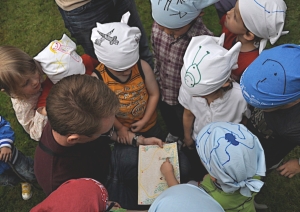 Thirteen dead-keen, albeit diminuitive, pirates duly appeared on the day, demanding entertainment with startling ferocity. So as soon as all the pirates had made scary drawings on their hats, we embarked on a journey across the high seas. The sails were hoisted, the anchor raised, and we set course for Thailand. Strangely enough, upon arriving there we sighted a party that looked suspiciously like parents sipping their wine. They were soon sent cowering, however, by volleys of our cannonballs.
Thirteen dead-keen, albeit diminuitive, pirates duly appeared on the day, demanding entertainment with startling ferocity. So as soon as all the pirates had made scary drawings on their hats, we embarked on a journey across the high seas. The sails were hoisted, the anchor raised, and we set course for Thailand. Strangely enough, upon arriving there we sighted a party that looked suspiciously like parents sipping their wine. They were soon sent cowering, however, by volleys of our cannonballs.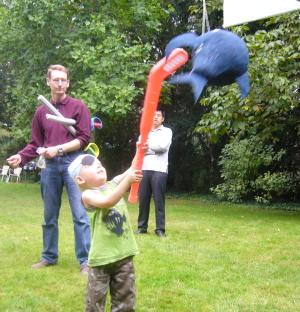 which involved following shapes marked on the map (see above) to find scrolls. These were hidden all over the garden and eventually led to the sandpit. Who could possibly have guessed that the treasure chest would be buried there? And, after it was laboriously dug out, it yielded eye masks, bubble blowers, pirate badges and chocolate gold coins, all neatly divided into fifteen portions. This fortunate coincidence averted fighting over the spoils — well for the most part, anyway.
which involved following shapes marked on the map (see above) to find scrolls. These were hidden all over the garden and eventually led to the sandpit. Who could possibly have guessed that the treasure chest would be buried there? And, after it was laboriously dug out, it yielded eye masks, bubble blowers, pirate badges and chocolate gold coins, all neatly divided into fifteen portions. This fortunate coincidence averted fighting over the spoils — well for the most part, anyway.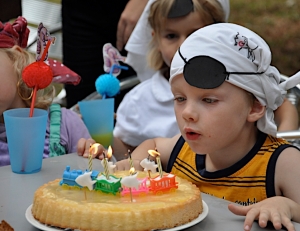 And finally it was time to head home for cake, rounding out a hearty day of pirate adventure.
And finally it was time to head home for cake, rounding out a hearty day of pirate adventure.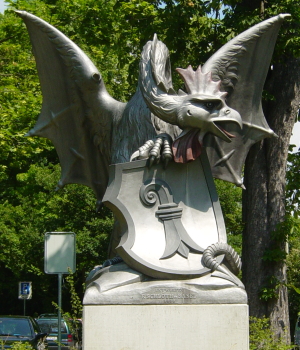 This menacing figure is one of four basilisks that were cast by
This menacing figure is one of four basilisks that were cast by  Along with their kids, we saw the local festival of St Maurice, which included a fascinating parade (one group comprised six locals plodding along together on a single pair of giant skis). Children were given helium balloons to release with their names and addresses attached, and Wiki’s managed to reach a friendly grandmother
Along with their kids, we saw the local festival of St Maurice, which included a fascinating parade (one group comprised six locals plodding along together on a single pair of giant skis). Children were given helium balloons to release with their names and addresses attached, and Wiki’s managed to reach a friendly grandmother  The five kids had great fun together, especially attending the
The five kids had great fun together, especially attending the  We twice had dinner outdoors at a restaurant on the banks of the river, with views to
We twice had dinner outdoors at a restaurant on the banks of the river, with views to  it was filled with narrow stone alleys and beautiful art galleries, but is far less touristed.
it was filled with narrow stone alleys and beautiful art galleries, but is far less touristed.  Time will tell whether this will slow him down, or simply be the first of a long sequence.
Time will tell whether this will slow him down, or simply be the first of a long sequence.